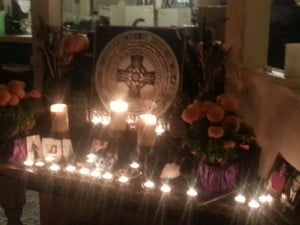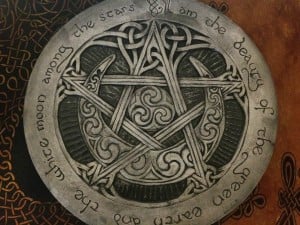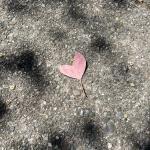Pantheacon 2014 was unusual in the level of acrimony some Pagans raised towards others about a supposed ‘Wiccan privilege’. I will soon have a article devoted to it here, but that is not this one. Here I want to explore the kinds of changes in America’s Pagan religions that made it possible for some to bring this charge. For in the years to come these changes will only increase. Our future is a diversity dwarfing what we presently are experiencing.
I will start with two basic observations.
First, when religious freedom exists religious traditions tend to diversify and depart from their real or imagined original unity. This is as true for religions building their message around a sacred scripture as it is for those with less ‘objective’ sources for their ultimate authority. One reason for this growing diversity is the distinction I drew between religion, which is a social activity involving many, and spirituality, which applies to every individual with spiritual beliefs, and which is usually more complex and multi-faceted than any religion. Spirituality is how each of us makes sense of the sacred in our own lives.
Because individual spiritualities are so personal, and often complex, religions offer simplified frameworks enabling us to find sufficient common ground to become a community of practice or worship. As I explained in the link above, they do this by providing a story of how we can relate to the more-than-human and get into better relationship with it. Because stories can be interpreted in many different ways, any group has the potential for division into more groups.
Second, Pagan religion focuses on our relations with a spiritual community encompassing the world. From an explicitly Pagan perspective neither this world nor we two leggeds tend towards any ultimate goal. In a sense we focus on attaining and maintaining good spiritual citizenship. The potential religious practices that can arise in such a world are limited only by the human imagination, though some work better than others, and speak to more people. These latter will flourish and others will remain small sects that normally decline or disappear once their founders pass away.
The implications arising from these two observations are that as Pagan traditions grow they will diversify, probably by a lot. Gardnerian Wicca, the first public NeoPagan tradition, has already diversified so much that some Gardnerians will not circle with others. This development is hardly unique among Gardnerians. It appears to be a universal feature of any religious tradition that lasts very long.
“Wicca” has changed dramatically from what it was 40 or 50 years ago. Back then it referred to Gardnerians and perhaps other British Traditional Witches. Today it includes many different traditions with no relationship to those original traditions beyond inspiration and some common terminology.
Today ‘Wicca’ is characterized by an increasingly abstract unity shaped by two themes: our common focus on the cycles of the natural world, particularly as the fit into the symbols and rhythms of sun and moon, and our emphasizing the masculine and feminine aspects of the sacred, with the feminine having pride of place. Wiccan working groups will likely continue to be called covens, and will continue to meet in a circle. Beyond this, I predict anything goes.
And today as Gardnerians are only a part of Wicca, Wicca is only a part of NeoPagan religions, which themselves are only a part of contemporary Pagan practice in America.
As they arise, new Pagan religions will seek to differentiate themselves from older ones while older ones will split between innovators exploring new meanings they see or think they see and conservatives who want to preserve what they regard as most central to their practice. Some splits almost certainly will end up as permanent divisions.
From a Pagan perspective the world’s very diversity encourages and legitimizes a variety of approaches. African Diasporic traditions constitute a vital and powerful Pagan (but not NeoPagan) tradition whose symbolism has nothing to do with Wicca’s. For example, they developed in tropical climates whereas the four seasons are central to vital Wiccan rituals. Native American traditions are also distinct. For example, NeoPagans have nothing like vision quests, a practice central to many tribes. Within the broad Native American tradition different tribes have different versions of practices almost universal among them, like the sweat lodge.
At a meeting last February at Pantheacon Don Frew, who for years has been deeply engaged in interfaith work with Pagan traditions outside the US, pointed out that as the America’s Hispanic population increases, we will see a variety of even more complex Pagan approaches, ones blending Pagan themes in semi-Christian contexts. These syncretistic amalgamations of Christianity with native Pagan traditions are found widely south of our border and increasingly here at home.
The growing popularity of Day of the Dead among Anglos as well as Hispanics is an example. I attended a celebration by the local Hispanic community where a Mexican dance troupe incorporated the Spiral Dance, and therefore we the audience, into their performance. As this tradition works it way more deeply into our culture we will be the richer for it.
Within the NeoPagan community those calling themselves “ChristoPagans” are another example of such blending, one I suspect in time will blur the distinction between Christianity and Paganism in an increasingly Pagan direction. The Christian story is morphing into the Pagan story.
Outside conservative Christian circles many Christians no longer view their religion as exclusively true and many are seeking greater recognition of the value of nature and of the feminine within their practices. This shift does not make them Pagan, their story is different from ours, but it does harmonize their approach with ours, and in the process strengthen the basic themes of Wiccan NeoPaganism.
In short, when freedom exists the boundaries between religions blur. This blurring moves them into greater harmony with, and in time perhaps becoming indistinguishable from the basic Pagan story. That story is of our existing within a community of spiritual relationships, where our chief task is being good members of that community.
The future of Pagan gatherings
Gatherings like Pantheacon will soon be unable to incorporate the full diversity of Pagan paths. In fact, if Pagan religions such as Santeria, Voudon, and Native American traditions sought representation in anything like their true diversity and numbers we would already be there. We are becoming too big as well as too diverse to enable every tradition or practice representation.
We should be happy about this. It is evidence of our success.
I doubt Pagan festivals will disappear. I certainly hope not. But it may be that they will increasingly divide along broad similarities with different traditions more as honored guests rather than seeking to represent everyone. There might be large Wiccan festivals, Heathen festivals, and others, with none claiming exclusivity in truth but all exemplifying a way of approaching the sacred in which their members feel at home.
If general Pagan festivals continue respected representatives of the various traditions will likely be emphasized. Since it will be impossible to represent every tradition, the kind of complaints we heard this year at Pantheacon will dwindle away. In my opinion this cannot happen too soon.
New small traditions will realize that simply existing gives them no call on everyone’s attention. Like Wicca did before them, and many others have since, they will have to prove their viability by growing in numbers and lasting for some years. This will not be ‘discrimination,’ it is what happens within every religious tradition that diversifies. Pagan religions will range between traditions practiced by a great many for many years all the way down to sects focused on a single teacher or deity and his or her followers.
Today Wiccan pre-eminence is based on the simple fact Wiccans were the first NeoPagans to have a visible presence in American society as a whole. Consequently it is we who most non-Pagans think of when they think about modern Pagans. But they rarely think about anything beyond those broad similarities I described earlier.
Today other traditions are reaching the numbers and visibility to become publicly visible on their own terms. Heathens are far along in this process. Others will follow, with perhaps the Druids being next. This is a good thing and no ‘power structure’ exists to hinder it.
Native American and traditions such as Voudon, long preceded Wiccans in this country but met largely in secret or within their own ethnic or tribal communities. As many still do. As a public Pagan presence grows, I suspect the all too justified fears that led to this secrecy will subside. Some will become more visible to the public and more engaged with other Pagans. As they do, Pagan life as a whole will be further enriched.
Wiccan ‘privilege’ never existed in any important sense, and Wicca’s status as the best known Pagan tradition in America will steadily diminish. Even so, I think for various reasons an increasingly diverse Wicca will remain the largest NeoPagan orientation. The most important reason I believe we will predominate for a long time among American EuroPagans is because our basic symbols and rituals are removed from any ethnic tradition. The English roots that Gerald Gardner and Margaret Murray thought Wicca possessed are not there, or remain in the most vestigial form. Wiccans easily accepted this discovery because it was not really central to our practice. In addition, the US is a country without a well-defined ethnic tradition of its own. Consequently Wicca’s universal symbolism and lack of ethnic identity beyond being European is appealing to many.
By contrast, in European nations many cultures retain at least a memory, occasionally a pretty good memory, of their pre-Christian traditions. In those nations the Pagan traditions that originally predominated there will have a strong attraction. In Russia, for example, at Pantheacon we learned that Slavic Reconstructionists outnumbered the Wiccans. I think it would be strange were it otherwise.
A deep transformation
The growing nihilism that characterizes modern America is a defining and destructive feature of modern life. It emerges from traditional Christian religion’s lack of fit with the modern world that in such large part is rooted ethically in the Christian story. Hopefully Pagan religion will begin breaking down the walls between what is secular and what is religious in American life, re-establishing awareness that we live immersed in value and beauty that goes far beyond mere subjective wishing. The growth of Pagan religion here can heal this spiritual wound not by replacing it with theocracy, as the Christian right desires, but an appreciating the many ways Spirit manifests in the world. Each tradition, including the best of the Christian is, to use my favorite image, a petal on a many petaled flower that is perpetually opening.
With this development the modern worldview’s two chief pathologies can begin their healing. The first is its division between ‘objective reality’ that supposedly exists independently of “subjective” consciousness where we find qualities such as beauty and love. The second is its division between the human world, where values apply, and the rest of the world, where any value comes only from their ability to serve us. These pathologies have eroded any sense of genuine meaning to our existence, and any sense of our world as consisting of valued relationships rather than of being surrounded by brute things.
This healing cannot happen any too soon. The modern world view has spawned practices and institutions that are destroying much of the other-than-human material world, and in the process even undermining human well-being. A sociopathic civilization cannot endure, and that is what dominant American culture has become. If, as I expect, Pagan practices and values gradually permeate our society, increasing numbers of Americans will be able to heal these splits in their own lives, and so provide a foundation for healing them in society as a whole.
Amid this rich spiritual diversity most of us will come together, I think, in a deeper appreciation for this sacred earth within which we live, and for feminine values as necessary correctives to the one sided masculine puffery that afflicts and distorts so much of our culture, secular and Christian alike.
And that will be quite enough.















